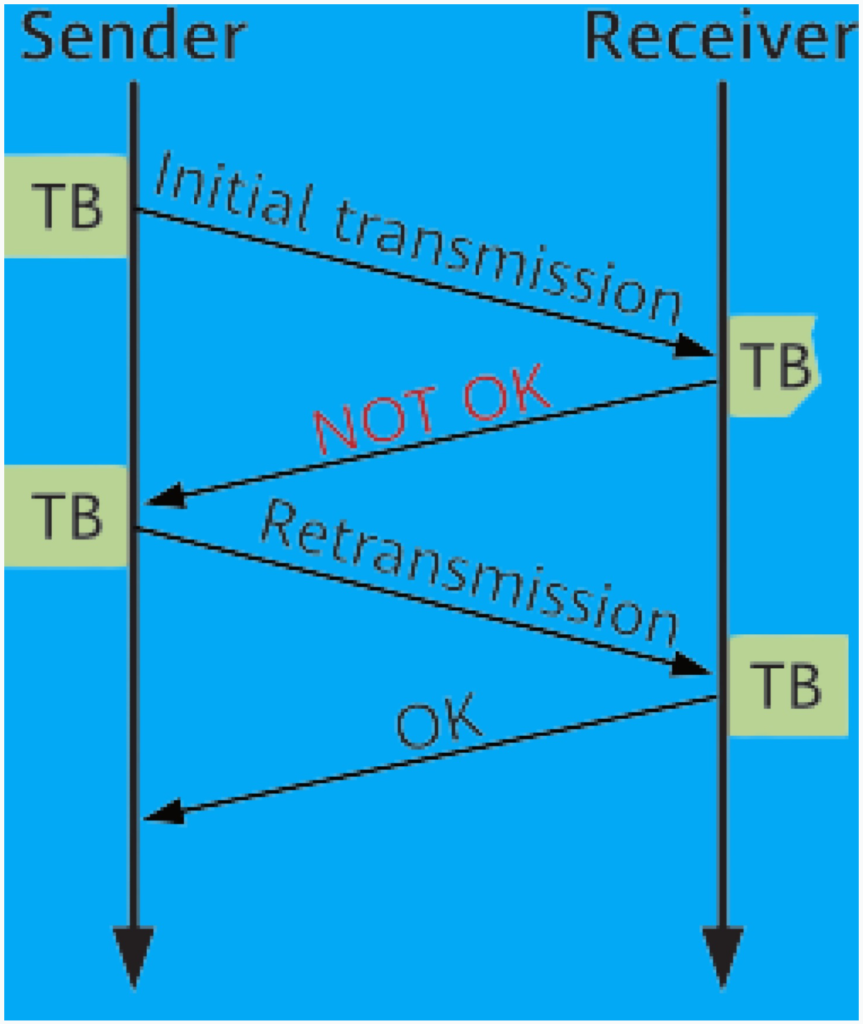Retransmission in telecommunications is similar to everyday situations where something needs to be repeated or resent due to a problem, like asking someone to repeat themselves when you mishear them or requesting a replacement for damaged goods received online. In the context of communication networks, the sender is like the person speaking or the seller, the receiver is like the person listening or the buyer, and transport blocks (TBs) are similar to the speech or purchased goods.

When a sender transmits a TB to a receiver, this is called the initial transmission. If the data is not correctly received, the sender may need to retransmit the TB. This process is crucial for ensuring the accuracy and reliability of data communication.
Retransmission Mechanisms in 5G NR (New Radio)
In 5G, retransmission is handled through mechanisms defined at various layers of the protocol stack, specifically at the MAC (Medium Access Control), RLC (Radio Link Control), and PDCP (Packet Data Convergence Protocol) layers.
1. MAC Layer Retransmission: Hybrid Automatic Repeat Request (HARQ)
HARQ is the primary retransmission mechanism at the MAC layer. After transmitting a TB, the receiver sends back an acknowledgment indicating whether the transmission was successful. If the transmission fails, the TB is retransmitted. HARQ operates quickly, providing immediate feedback. While HARQ is efficient, it has a feedback error rate of about 1%, which is not sufficient for ultra-reliable, low-latency communication (URLLC) scenarios. To improve reliability, more signaling is required, increasing control overhead.
2. RLC Layer Retransmission: Automatic Repeat Request (ARQ)
ARQ supplements HARQ by providing a retransmission mechanism at the RLC layer. ARQ operates with less frequent feedback, reducing overhead while maintaining a low feedback error rate. HARQ and ARQ can work together to meet the varying requirements of different data transmission scenarios.
3. PDCP Layer Retransmission
PDCP layer retransmission is mainly used during inter-gNodeB handovers (when a mobile device moves from one base station to another). It ensures no data is lost during handovers by maintaining data in the PDCP layer while lower-layer buffers (RLC and MAC) are cleared.

Focus on HARQ at the MAC Layer
The HARQ mechanism at the MAC layer is critical for ensuring fast retransmission and efficient communication. Despite its limitations, HARQ plays a very important role in maintaining the balance between speed and reliability in 5G networks.
1. What is 5G NR HARQ? Click for Complete Technical Details.
2. RLC Retransmission.
When data is not correctly received despite the maximum number of HARQ retransmissions at the MAC layer (a limit typically configured by vendors), retransmissions are escalated to the RLC (Radio Link Control) layer. The RLC layer supports three distinct data transmission modes, each serving different communication needs:
- Transparent Mode (TM): In this mode, the RLC layer does not modify the data packets. It simply passes the data transparently to the adjacent layers without segmentation, header addition/removal, or retransmission. TM is primarily used for transmitting system information, paging messages, and specific signaling messages like Msg2 to Msg4.
- Unacknowledged Mode (UM): Here, the RLC layer segments data packets but does not support retransmission. UM is suited for services where low latency is critical, such as Voice over NR (VoNR) and other delay-sensitive applications.
- Acknowledged Mode (AM): This mode provides reliable data transmission by supporting segmentation, reassembly, and ARQ (Automatic Repeat reQuest) retransmission. AM ensures that all transmitted data packets are correctly received by the peer end and that no data is lost over the air interface. This mode is ideal for error-sensitive and delay-tolerant non-real-time applications like web browsing, FTP downloads, and signaling transmission.
Retransmissions at the RLC layer occur exclusively in Acknowledged Mode (AM). When a receiver detects an incorrect Protocol Data Unit (PDU), it sends a status report to the sender, prompting a retransmission of the erroneous PDU. This status report can be sent either proactively by the receiver or upon request by the sender. For example, if the sender’s buffer becomes full due to unacknowledged PDUs, the sender may request the receiver to send a status report to manage the flow of retransmissions.
3. PDCP Retransmission.
PDCP (Packet Data Convergence Protocol) retransmissions become crucial during inter-gNodeB handovers to ensure data continuity. During a handover, both the gNodeB and the UE reconfigure the MAC entity and reestablish the RLC entity to maintain the connection.
In the downlink, the PDCP layer forwards any unacknowledged data packets to the target gNodeB for retransmission, ensuring that the data reaches the UE even after the handover.
In the uplink, the UE’s PDCP layer retransmits any data that has not been sent before the handover. This process guarantees that no data is lost during the transition between gNodeBs, providing a seamless handover experience.